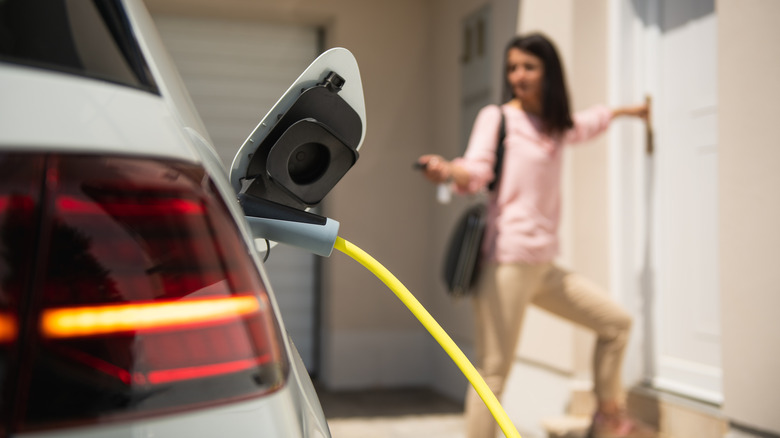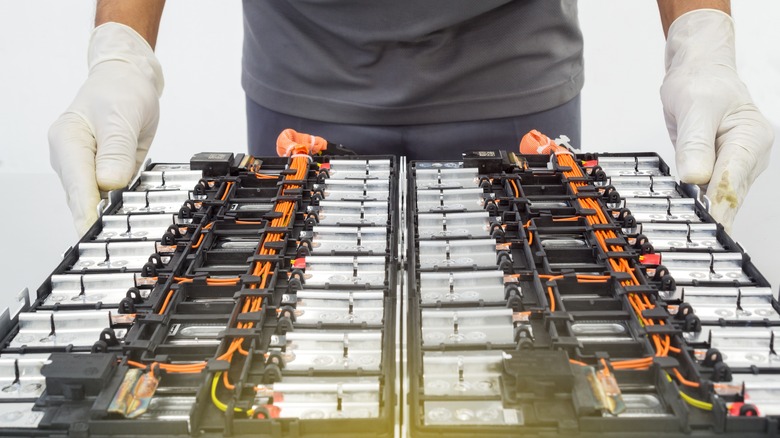Which Electric Cars Qualify For The New EV Tax Credit?
The inflation reduction act (IRA) was recently passed through congress and is on its way to President Biden's desk. Alongside huge investments in energy infrastructure and extra funding for the IRS, the bill also includes sweeping changes to the electric vehicle tax credit system. These changes will affect both used and new electric vehicle buyers, and some major manufacturers will see it as a huge win. But, if you're planning on purchasing a new EV any time soon, you may get less back than you think.
When it comes to the IRA's tax credit changes, Tesla, GM, and Toyota are the big winners. All three companies had passed the 200,000 qualifying vehicle limit the old tax credit system implemented, meaning all of the vehicles they had manufactured since were ineligible for the old $7,500 credit. The new system has no limit on the number of vehicles that qualify, so — if the manufacturers manage to meet the other conditions outlined in the bill — their customers can once again claim money back on new purchases.
Used car buyers are also likely to benefit from the bill. They now qualify for a tax credit equivalent to 30% of the vehicle's purchase price, up to a maximum of $4,000. This is the first time used electric vehicles have been eligible for a tax credit, even if that credit is just over half what those buying a new vehicle can get. Used car buyers may also have a far easier time claiming money back from the government under the new system.
Income caps have been introduced for the first time, while a max purchase price has been set at $55,000 for electric sedans and $80,000 for all other electric vehicles. Scratch the surface, though, and things get even more complicated than that.
Fewer new EVs qualify for the new credit than you may think
Far fewer cars qualify for the new credit than you might think, and it's possible no electric vehicles currently on sale in the United States qualify for the new credit. The problem is centered around the batteries that power the vehicles. Where previous credits focused on the vehicle's total battery capacity, those introduced by the Inflation Reduction Act center around where the battery was manufactured and the origins of the materials used. To qualify for half of the credit, the batteries used in the vehicle must be manufactured in North America.
Several manufacturers, including Tesla, GM, Ford, and Volkswagen, are already shifting battery production facilities to the North American continent. So if no vehicles currently qualify for the credit, there is a reasonable chance some buyers will be able to get at least $3,750 back in the near future. Getting the other half may be trickier.
The key ingredients in an EV battery are lithium, cobalt, and graphite. As Ars Technica points out, most of the world's cobalt, over 60% of its lithium, and close to 100% of its graphite is processed in China. To qualify for the other half of the credit as soon as the bill is signed, at least 40% of the materials used in those batteries need to be sourced from North America or a country the United States has a free trade agreement with. To make matters worse, that figure goes up by 10% each year.
The United States does have fairly vast lithium deposits, but it currently lacks the capacity to extract and refine the amounts needed to hit the 40% threshold. By the time production scales up, the percentage required will have likely scaled up, too. Consumer Reports compiled a list of current EVs that may qualify for some — if not necessarily all — of the new federal tax support.
If you've recently ordered an EV, there's a chance you won't miss out
As soon as President Biden signs the IRA into law, the old tax credit system for electric vehicles will end. There is no planned transitional period while the industry adapts to the new demands, and nor is there a grace period for people wanting to pull the trigger on a new EV purchase. There is every chance there will be a prolonged period where electric vehicle subsidies are rare or even non-existent. But what if you've already put your deposit down on a new EV? Well there is some hope there, but it's a little confusing in practice.
The bill contains a "transition rule" that allows people who "purchased, or entered into a written binding contract to purchase" a qualifying EV between December 31 last year and the day the bill is signed to treat the car as if it were in service before the law was enacted and claim their full tax credit. However, a refundable reservation on an EV isn't necessarily legally binding, and may well not count under the transition rule. But there may still be a way around it if you act quickly enough.
Auto analyst Sam Abuelsamid speculated that people who have reserved a new electric vehicle have up until President Biden puts his signature on the bill to contact their dealership and turn their reservation into a legally binding contract. In short, even if your new EV's production date is some way out, if you have the contract for it now, you should still qualify under the old rebate system.
The language in the bill is quite vague, and a lot is left to how the Secretary of State interprets it once the act is signed into law. If you've recently purchased an EV or intend to purchase one in the near future, it's probably worth contacting a dealership or tax lawyer and getting their take on things. Otherwise you could find out your new electric car costs you more than you first expected.


